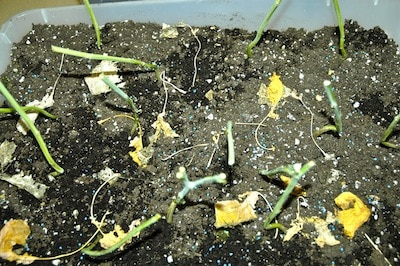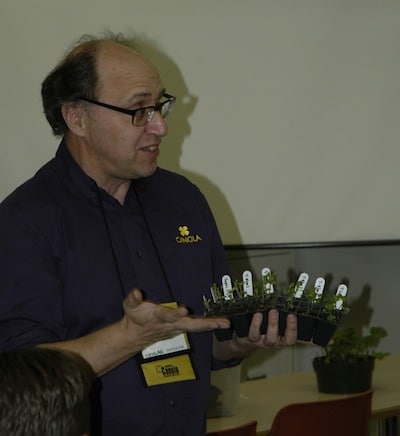CanoLAB 2015 wraps up this week in Brandon. The following short summaries from a few of the many CanoLAB instructors outline key “take home” messages for the eight topic areas.
Session: Harvest Management — Cutting your losses

Kerran Clements, Dekalb agronomist in Alberta: Make swath timing decisions based on seed colour change, not pod colour change. And at all costs, wait for 60% seed colour change, or more. Dekalb trial studies show that canola cut at 60% seed colour change yields 5.5 bu./ac. more than canola cut at 20% SCC.
Leighton Blashko, senior market development specialist, Bayer CropScience: When it comes to straight combining canola, don’t jump in with both feet. A lot of steps are involved in doing it successfully, including early season steps to set up the field for straight combining, but it can pay dividends if these steps are taken.
Session: Macros & Micros — Size matters
Jack Payne, agronomy instructor at Olds College. As potential yield increases, nitrogen use efficiency improves. Growers may need 3 pounds of nitrogen for each bushel of yield for the first 35-40 bu./ac., but after that the requirement drops. On average, high yielding canola may require 2-2.5 pounds of N per bushel of yield.
Tom Jensen, director, North America Program, International Plant Nutrition Institute: Plant analysis and soil testing will help growers choose the rate and nutrient mix suitable to each field. And when it comes to product choice, keep in mind that crop nutrition products no longer have to prove efficicacy, so there is a need for local research to test product efficacy and return on investment.
Session: Breeding in the Bag — Genetics and seed production
Scott Horner, general manager with hybrid seed producer HyTech Production: Hybrid seed is significantly more complex and costly to produce than open pollinated seed in part because of the multi-step parent line production process requiring very high levels of purity and the need for parent line management and bee pollination in the production field.
Dale Burns, canola breeder with Monsanto Canada: Breeding innovation is moving at a pace we’ve never seen before. That increases development costs, but it also brings yield potential and yield stability that hasn’t been there before. The industry needs these advancements in hybrid breeding and seed production to help farmers achieve a 52 bu/acre average.
Session: Missing Pods — Where did they go?
Murray Hartman, oilseed specialist with Alberta Agriculture and Rural Development: In order to identify what stress has caused missing pods, you have to be in the field at bud and early flower stages. You can often tell from flower petal colour, petal size and stamen length what caused the stress that leads to missing pods.
Session: Understanding Disease Resistance

Ralph Lange, plant pathologist with Alberta Innovates Technology Futures: The rate of pathogenic adaptation is way faster than the breeding cycle, so crop rotation and other resistance management steps are really important to canola yield and sustainability.
Session: Good Grades & Crushing
Adel Ghabour, quality assurance manager with Richardson Oilseed: When it comes to processing canola, green seed, heated seed and high moisture seed all add to the cost to produce refined canola oil. Heated seed produces increases free fatty acids and caustic (NaOH) has to be added to neutralize FFAs. This is then removed with water. Clay is used to bind to chlorophyll, and this clay adds to processing costs. Also high levels of chlorophyll requires more retention time in the bleacher which reduces production flow. And all canola is dried to approximately 7% moisture before processing, so higher moisture canola required more retention time and energy to dry it.
Bill Adduano, operations supervisor with the Canadian Grain Commission’s Calgary service centre: Know your dockage and quality before marketing. Use CGC programs such as the Harvest Sample Program to get a read on quality, and the “Subject to Inspectors Grade and Dockage” service to settle grade disputes.
Session: Bees & Beneficial Insects

Vincent Hervet, PhD student at the University of Lethbridge: Maintain biodiversity all year round in and around the field to preserve beneficial insects and avoid or limit pest outbreaks. Scout, follow thresholds, and avoid spraying insecticide and herbicide unless it’s necessary. Keep plants around field margins and ditches to provide habitat for beneficials. When you kill everything in a field, the first insects to come back are the pests.
Eric Stromgren, commercial beekeeping instructor at Grande Prairie Regional College: Bees and pollinators love canola, but it would be nice to have other crops around that flower before and after canola to provide them with food for more months of the year. The best would be if 10-20% of the landscape had plants, such as alfalfa, clover, that bloom other than when canola blooms. Healthy pollinators also benefit canola yield.
Session: Insect Thresholds & Damage Assessments
Justine Cornelsen, CCC agronomy specialist: When dealing with various pests across the growing season it is important to understand the life cycle of each pest, when to scout for them, identification of pests’ natural enemies, how to assess damage, and how to determine economic threshold numbers for spraying. Incorporating integrated pest management techniques will help to decrease pest damage and allow for beneficial insects to thrive; all while making your canola crop more profitable.
